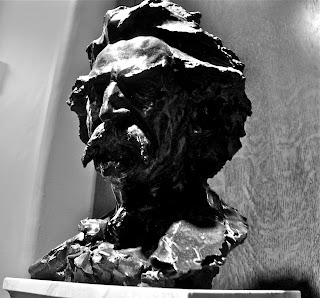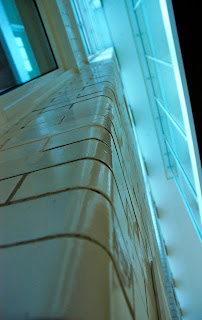It got me thinking about the intense, blind loyalty or even love some have for their University and everything that it means and represents. From sports teams, to school colors, to the institution itself, Americans generally LOVE their local college/university and sports teams.
I'm not getting that vibe here though. St. Louis, a city of ~318,000 people only has 2 universities. The extremely small Harris-Stowe State University and the much larger and renowned St. Louis University.
Here's a little background on Harris-Stowe:
Harris–Stowe State University is a historically black public university located in Midtown St. Louis, Missouri. Founded in 1857, Harris–Stowe State University is one of the oldest institutions of higher education in Missouri. Founded by the St. Louis Public Schools as a normal school, it was the first public teacher education institution west of the Mississippi River and the twelfth such institution in the United States. During most of this period, the emphasis focused on teacher education, however, Senate Bill 153 enacted in 1993 enhanced the mission of Harris–Stowe to include a wider selection of degree opportunities. Harris–Stowe State University was called Harris–Stowe State College until it was renamed in August 2005.The second of course is St. Louis University.
Harris–Stowe State offers over twelve degree programs including: Bachelor of Science in Education, Bachelor of Science in Urban Education, Bachelor of Science in Business Administration with specialization areas, Bachelor of Science in Health Care Administration, Bachelor of Science in Accounting, Bachelor of Science in Hospitality and Tourism Management, Bachelor of Science in Information Systems and Computer Technology with specialization areas. (source)
Saint Louis University is a private, co-educational Jesuit university located in St. Louis, Missouri, United States. Founded in 1818 by the Most Reverend Louis Guillaume Valentin Dubourg SLU is the oldest university west of the Mississippi River. It is one of 28 member institutions of the Association of Jesuit Colleges and Universities. The university is accredited by the North Central Association of Colleges and Secondary Schools. SLU's athletic teams compete in NCAA's Division I and the Atlantic 10 Conference. It has a current enrollment of 13,785 students representing all 50 states and more than 77 foreign countries. There are currently 8,406 undergraduate students enrolled in SLU as well as 2,437 graduate students and 2,942 professional students. This year’s enrollment marks the first year that SLU’s enrollment passed 13,000. Of all the students, 59 percent are from out of state. The university provides undergraduate, graduate and professional programs. Its average class size is 23 and the student-faculty ratio is 13:1.Not too shabby, eh? St. Louis is such an important city when it comes to firsts in American history and westward expansion. We are truly the Gateway to the West and SLU is a part of that amazing American story. A potential source of regional pride if there ever was one.
Its Madrid, Spain campus has from 600–650 students, a faculty of 110, an average class size of 18 and a student-faculty ratio of 8:1.
Saint Louis University (SLU) is located on Lindell Boulevard, originally outside the City of St. Louis in an area originally called Lindell's Grove, and is the second-oldest Jesuit college in the nation. The first M.D. degree awarded west of the Mississippi was conferred by Saint Louis University in 1836. (source)
Other regional universities including McKendree University, Maryville University, Washington University of St. Louis, University of Missouri-St. Louis, Fontebonne University, Webster University, Southern Illinois University-Edwardsville and Lindenwood University are located outside of St. Louis' boundaries in the suburbs and small towns in Missouri and Illinois.
So for all intents and purposes, SLU is our only major division 1 university in the city and even the region. Washington University in St. Louis has a fantastic global reputation and is a trusted key partner with and investor in St. Louis in the East Loop, Barnes-Jewish Medical Complex, Central West End, West End, Forest Park Southeast, Skinker-Debaliviere, and other neighborhoods of St. Louis. Wash U is ranked the 14th best University in the nation, right between Johns Hopkins (Baltimore, MD) and Brown (Providence, RI)...not bad company, eh? Wash U is essential to our region and have done and continue to do lots of great things for St. Louis even though they are located in University City, Missouri a streetcar suburban city of ~36,000 that abuts the western border of St. Louis. Close, but no cigar (until the region can put aside its differences and just merge like other progressive cities/regions are doing)...Wash U continues to be a leader in the region and employs more people in the city than any other institution.
But back to St. Louis University...
For most of my time in St. Louis, I've lived far from St. Louis University. Living in the farthest reaches of South City, I had such a fondness for SLU as an outside observer. I'd occasionally drive around the Grand and Lindell area and look at that awesome cathedral and the old campus and just think what a beautiful setting for a school. Furthermore, I split season tickets to Billikens basketball games in the Larry Hughes years, and became a big fan of his crossover dribble, Conference USA rivalries with other major urban universities, SLU basketball and the whole college game experience as a result. Since then, SLU moved to a lower-grade conference that is way less competitive and has no local or otherwise rivalries...BORING to most outside of the die-hard fans.
However, I recently moved to a neighborhood much closer to SLU, so I've seen the other side of their campus in much more detail...the medical side mainly in the Gate District and the Tiffany neighborhoods.
Now, I've got to be up front here. I love SLU and want nothing more then for them to do well. I root for them in basketball more than my alma mater. They are now "my team". If all goes as planned, my kids will attend undergraduate university here...and I'd be a proud papa. My wife works for SLU, and she has a great job that she genuinely likes and really enjoys working at a non-profit higher place of learning.
Yet, St. Louis as a whole and especially residents and neighbors around SLU's main and medical campuses seem to be particularly split on SLU as a positive entity in St. Louis. Some are adamantly against the destructive policies as seen near the medical campus in recent years. They are tearing down all the homes immediately surrounding the medical campus. Instead of trying to get medical residents, employees and students living near the hospital, center of advanced dental care, etc...SLU is demolishing homes, leaving more mowed weed fields/grass lawns with "No Trespassing" signs and zero development. There are no communications, no plans revealed to those investing and living around the area, just seemingly mindless destruction and further isolation of the school from the city.
As a recent example, they are closing formerly through streets including Virginia Avenue in the Gate District neighborhood and taking away street parking presumably to guide patients and employees into pay lots that SLU owns. Bye-bye urban street grid, hello fallow acres of nothingness and mowed weeds:
the formerly through Virginia Avenue near Rutger on SLU's medical campus
I'm not the first to make this observation, those much more informed and articulate than I have drafted posts on these topics.
I can't help but feel that SLU will continue its intents to fence off their campus from the surrounding neighborhoods and city. They want no one other than SLU employees, students and associated patrons to be able to access the campus. They are blocking out the residents with fences, no trespassing signs, etc.
Now on the other hand, SLU recently completed a beautiful athletic track for the Track and Field Team. It is not fenced in, and neighbors are allowed to use it. People play soccer in the middle, and walk/jog on the track. It is awesome, has great views of Downtown and is a great place to get some exercise.
Secondly, there is a small garden/chicken farm right at Compton and Caroline maintained by the food sciences dept and the fruit, veggies, grains, herbs and eggs are used by the school and served to employees and students on the medical campus...this cafeteria called Fresh Gatherings operated by the school's Department of Nutrition and Dietetics is AWESOME and my wife brings home great stuff from here, and we buy family and friends reasonably priced fresh bread and spices grown, dried, processed and sold as gifts and cooking supplies. Anything the cafeteria can't produce, they get locally to the best of their abilities. Miller hams, Cherokee street tamales, Missouri/Illinois farmed-raised beef comes from within 150 miles of campus, etc.
They have a summer culinary camp for kids. It's freaking awesome. I would love my kids to ride their bikes to this summer camp.
I mean, wouldn't you love to live close to the campus to walk to work or a soccer game or a basketball game or rock show at the student center? I would. I would love to fly the Billiken flag and be proud, but they seem to not want the citizens and residents of Tiffany, Gate District, Midtown, etc to engage as part of the SLU world...they seem to want to get rid of people and places on the periphery of their campuses.
Furthermore on the negative tip, the recent loss of the Pevely dairy outbuildings and smoke stack (latter of which was listed on the historic register) were destroyed to make way for an ambulatory care extension...that they all of a sudden said, you know what, never mind on all that. And now those that live around here or own property around here have to have passers by witness SLU's abandoned piles of debris as part of their daily lives. Thanks a lot for that. To pour salt in the wounds of those who like historic buildings and cities vs. suburbs, SLU threatened to move to the county if they didn't get to destroy these structures even though they own acres of already leveled, vacant property throughout the city. A slap in the face to this proud city lover and many others.
Ideally, SLU would engage the community in their plans. Most rational thinkers and investors in the area would put up with the lingering mounds of debris and mourn the loss of the Pevely office building and smokestack...but, if they were going to build a shiny new urban building sensitive to the surrounding city, then I would be totally cool with it. If they had a long term plan to build new housing for its residents, students, etc, I'd be all for progress. But that is not how the current administration rolls/rules. Wash U behaves much better in the CWE, they don't leave people hanging, make bullying threats to the city leaders and preservationists alike...they seem to respect the city and want to be part of it and build it up not isolate it and privatize it.
SLU's leadership seem suspect at best from afar. A recent vote of no confidence in the current president, Lawrence Biondi, by the faculty and students further erodes my confidence in the institution and its future. Or, maybe this is a sign of brighter days of transparency and community cooperation as opposed to my way or the highway tactics.
I can't allow myself to believe that Biondi or SLU is evil or hates the city it resides in. I just think they are arrogant, ignorant and short sighted. I would like to think that they are trying to improve the campus; but it seems only to the benefit of SLU and not St. Louis. I don't think those currently in charge understand that SLU should be striving to be part of the city and not a fenced off entity who feels stuck in the city. This is why I think many locals and residents of St. Louis can't fully get behind SLU like other American college towns get behind their school/team. Penn State this ain't. University of Illinois, Butler, Mizzou...forget it, nothing like that.
I'm trying to be reasonable and get on board...but Biondi's regime makes it nearly impossible. I mean look at the beautiful, modern, Canon-designed research building at Grand and Chouteau...it is utterly beautiful and awesome; but they surrounded it with a vast expanse of grass and fountains and fences and dead space that will NEVER add to my city. It's an utter dead zone devoid of anyone...student, resident, employee, anything. An urban moat on the outskirts of a castle.
I am concerned about SLU as a neighbor. I am concerned about them as a University. I am concerned about their reputation. So is the faculty. I want to feel loyal to SLU and be proud of the institution as a neighbor. SLU is a great place, I want nothing for them to succeed and grow and continue to educate and invest. I want my kids to go here...I want them to be responsible and respectful to STL.
SLU, please turn those acres of green pastures into something before you knock down another irreplaceable building. Show us a plan, quit closing down our streets, quit knocking stuff down without so much as a peep as to what is going on. Quit bullying the residents of St. Louis. St. Louis leaders, quit pandering to these bullies...you look cheap and unimaginative and intimidated...weak.
SLU is our greatest historic place of higher learning in the city limits. Please, please engage the community in your future...it can only help build trust, Billiken pride and loyalty to a fantastic historic university. I'm ready to wave that blue and white flag.
Here's to a better future...why not start in 2013.


















































































































































